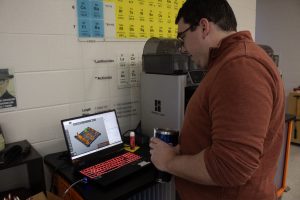News

SB 29, designed to protect student privacy, is causing headaches for some school districts
By: Theo Peck-Suzuki | Report for America
Posted on:
NELSONVILLE, Ohio (WOUB/Report for America) — When Nick Conroy teaches his class on 3D printing, he likes to wander around the room, checking on students’ work.
Since Senate Bill 29 went into effect Oct. 24, he’s been staying at the front of his classroom. The only time he checks students’ work is when they come to him because they’re stuck. Otherwise, he won’t even evaluate their designs; to see if they got everything right, they have to print the object so that it exists outside of a computer.
Conroy, who teaches at Nelsonville-York High School, says the reason for this change is broad uncertainty about what exactly counts as a violation of SB 29.
“No one knows where that line’s at,” he said.

“Teachers could be held responsible. Their licenses could be revoked if they are in breach of this,” Conroy said.
State Sen. Matt Huffman introduced SB 29 in February 2023. At that time, he said the bill “moves to prohibit schools and technology providers from tracking student activity from school-issued devices.” His concern was that schools and technology companies had too much access to students’ devices, even after kids brought them home.
The bill later passed the House and Senate on a near-unanimous vote.
Nelsonville-York Superintendent Rick Edwards said SB 29 prohibits schools from accessing student accounts. This has caused a particular problem for Nelsonville. The district uses Google Classroom, which stores all student work in the student’s individual account. If a teacher goes to look at an assignment, that might technically violate the law.
“What it has done to us is made us go back in time,” Edwards said.
Some teachers are now reverting to pencil and paper assignments, which must be individually hand-graded. Conroy said he’s doing that with his chemistry class.
Conroy still uses computers for the 3D printing class — there’s no other way to use a 3D printer — but he has had to change his approach in ways he feels are counterproductive.
“So the safest thing for us to do is be like, ‘When you have questions, come to me. I’ll be up here.’ Which again is like, teaching 101 badness. You wanna float around your room, you wanna like, ‘Hey, check number two,’” he said.
Some groups expressed concerns this might happen during testimony about SB 29. Ben Cech of The Ohio Education Computer Network testified on June 25 that the definition of a “student-issued device” was too broad. “Without amending this definition, we risk restricting the use of everyday tools that are crucial for student learning and safety,” Cech stated.

Athens City Schools Associate Superintendent Chad Springer said the primary software his district uses, Canvas, is SB 29 compliant. The district will take a full inventory of programs teachers are using over the next couple of months.
Springer said during the pandemic, many teachers took the initiative and found new software to help with remote learning. Now, they have to go back through and make sure everything they picked up fits with the new law.
“It raised a lot of anxiety in educators: ‘Am I doing something wrong,’ those types of questions,” Springer said.
He’s meeting with every building in the district to offer clarity and reassurance to teachers.
Moving forward, Springer said, he expects SB 29 compliance to become an important factor for educational software providers.
“A lot of these companies out there, if they don’t change their contracts to follow SB 29, they’re not going to be able to provide service in Ohio,” Springer said.
Edwards and Springer said they expect legislators to meet in the coming weeks to clarify the law’s expectations.

